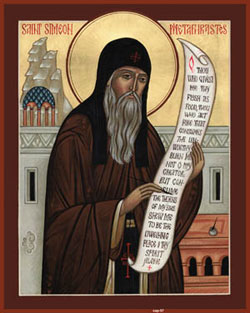
St. Simeon Metaphrastes (fl. X Century) was a civil servant who became a monk when he was old. Little is known about his life. When he was secretary of statae, he compiled the ten volumes of the Menologion at the request of Emperor Constantine VII Porphyrogenitus. Simeon collected the lives of the saints from oral tradition and written collections. He copied some lives as written and rewrote others. He arranged the lives in the order of the saints' feast days, and his work became so popular that many earlier hagiography has been lost. He also wrote a history of the world and a collection of the sayings of the church fathers. Simeon is sometimes identified as Simeon Logothelite.
10th-century Byzantine historian and hagiographer Russian icon of Symeon Metaphrastes
Russian icon of Symeon Metaphrastes
Symeon, called Metaphrastes or the Metaphrast (died c. 1000), was a Byzantine writer and official. He is regarded as a saint in the Eastern Orthodox Church and his feast day falls on 9 or 28 November. He is best known for his 10-volume Greek menologion, or collection of saints' lives.
About Symeon's life few details are known. He lived in the second half of the 10th century. Ephrem Mtsire puts him at the peak of his career in the sixth year of Basil II (982). Yahya of Antioch also makes him a contemporary of Basil II and Patriarch Nicholas II of Constantinople (984–991). In the 15th century, Mark Eugenikos wrongly called Symeon a megas logothetes. The hagiographer actually lived a generation later than the historian Symeon Logothete.
Symeon wrote mainly hymnody and hagiography. He composed kanones, stichera and a hymn to the Trinity. He also compiled excerpts of the church fathers, particularly Basil the Great. His most important work by far, however, is the menologion, which Albert Ehrhard labelled "a revolution in the field of hagiography". According to tradition, it was commissioned by Basil II.
Symeon's menologion is a product of the encyclopedism characteristic of the Macedonian Renaissance. He did not merely collect and arrange pre-existing saint's lives, but also reworked them, standardizing their language and embellishing their rhetorical style to bring them in line with the Atticism of the day. His nickname comes from this act of metaphrasis. The content of the lives was not altered, however, and historical errors were left intact. Symeon arranged them according to their feast days in the Eastern Orthodox liturgical calendar. There are about 150 distinct lives.
For his menologion, Symeon received praise from Nikephoros Ouranos and Michael Psellos addressed to him an encomium. It was widely read in monasteries. The standard edition came in ten volumes. Numerous illuminated copies were produced in the 11th century.

